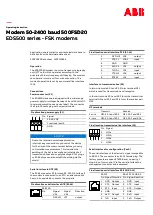DIVA T/A ISDN Modem User’s Guide
◆
Page 58
The DIVA Terminal Adapters Program for Macintosh
About Configuration Profiles
A profile is a set of parameters that define a particular ISDN setup.
When you installed the DIVA software, the Configuration Assistant helped you configure your
ISDN settings. These settings were saved to Profile 0.
In addition to this profile, you can configure two other profiles that define different ISDN
setups, which can correspond to the needs of your different applications. For example, you
may configure profiles to match the ISDN setup needed to connect to your office, your
Internet Service Provider (ISP), and CompuServe.
When you need a particular ISDN configuration, you simply select the appropriate profile.
This saves you the trouble of reconfiguring all your ISDN parameters each time you switch
applications.
Parameter Categories
The different settings are described briefly below. The categories correspond with the panels
in the Configuration Tool.
Configuring Profiles
•
To configure a profile manually using the Configuration Tool, see page 60.
•
To configure a profile using the Configuration Assistant, see page 71.
Protocol
This tab specifies your ISDN protocol. For more details, see page 62.
Location
This tab specifies the location's ISDN switch type and telephone numbers as
required. For more details, see page 63.
Phone
Lines
This tab specifies information about the location's phone lines and is only required if
your DIVA T/A is equipped with analog device ports. For more details, see page 64.
BACP
The BACP tab allows you to specify the Bandwidth Allocation Control Protocol and
ISDN cost reduction parameters. This tab is visible only if the data protocol is set to
‘MultiLink PPP’. For more details, see page 65.
X.25
X.25 only applies if AO/DI is supported by your ISDN service provider and if the
AO/DI option is enabled in the Protocol tab. For more details, see page 68.
Advanced
Advanced ISDN parameters such as Dynamic Bandwidth Allocation (DBA). This
information is optional. For more details, see page 70.


















